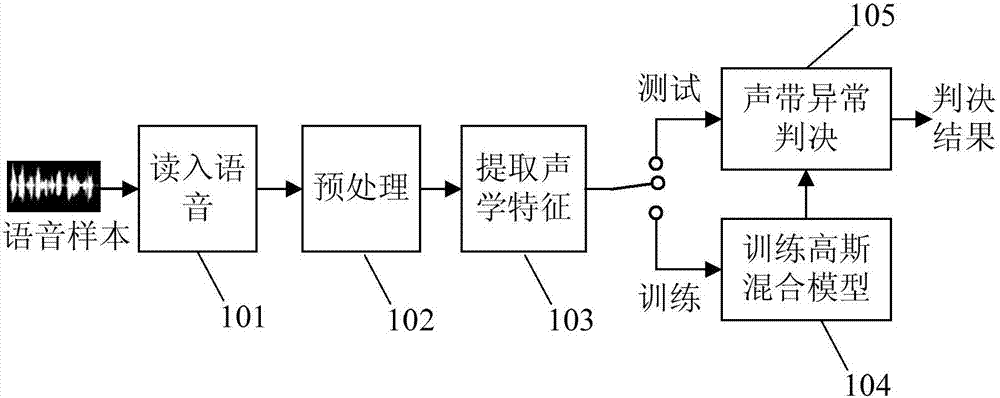Vocal cord anomaly detection method based on acoustic phonetic features
An acoustic feature and anomaly detection technology, applied in speech analysis, medical science, diagnostic recording/measurement, etc., can solve problems such as the inability to detect vocal cord vibration, the tester's inability to speak normally, and the tester's discomfort
- Summary
- Abstract
- Description
- Claims
- Application Information
AI Technical Summary
Problems solved by technology
Method used
Image
Examples
Embodiment
[0103] like figure 1 Shown is the flow chart of the embodiment of the present invention, and concrete steps are as follows:
[0104] First, in step 101, the collected voice samples are read.
[0105] Then, in step 102, the voice data read in is preprocessed, and the specific steps are as follows:
[0106] 1. Pre-emphasis: use the digital filter h(n) to filter the voice data, and the Z transformation H(z) of h(n) is expressed as:
[0107] H(z)=1-μz -1 ,
[0108] Among them, μ takes 0.98;
[0109] 2. Framing: process the pre-emphasized voice data into frames, frame length L=30ms, frame shift S=15ms;
[0110] 3. Windowing: each frame of speech S t (n) is multiplied by the window function, where the window function is the Hamming window ω(n):
[0111]
[0112] Among them, N represents the number of sampling points of a frame of speech, and N=L×f s , where f s Indicates the voice sampling frequency;
[0113] 4. Unmute:
[0114] 4.1. Calculate the voice S of the tth fr...
PUM
 Login to View More
Login to View More Abstract
Description
Claims
Application Information
 Login to View More
Login to View More - R&D
- Intellectual Property
- Life Sciences
- Materials
- Tech Scout
- Unparalleled Data Quality
- Higher Quality Content
- 60% Fewer Hallucinations
Browse by: Latest US Patents, China's latest patents, Technical Efficacy Thesaurus, Application Domain, Technology Topic, Popular Technical Reports.
© 2025 PatSnap. All rights reserved.Legal|Privacy policy|Modern Slavery Act Transparency Statement|Sitemap|About US| Contact US: help@patsnap.com



